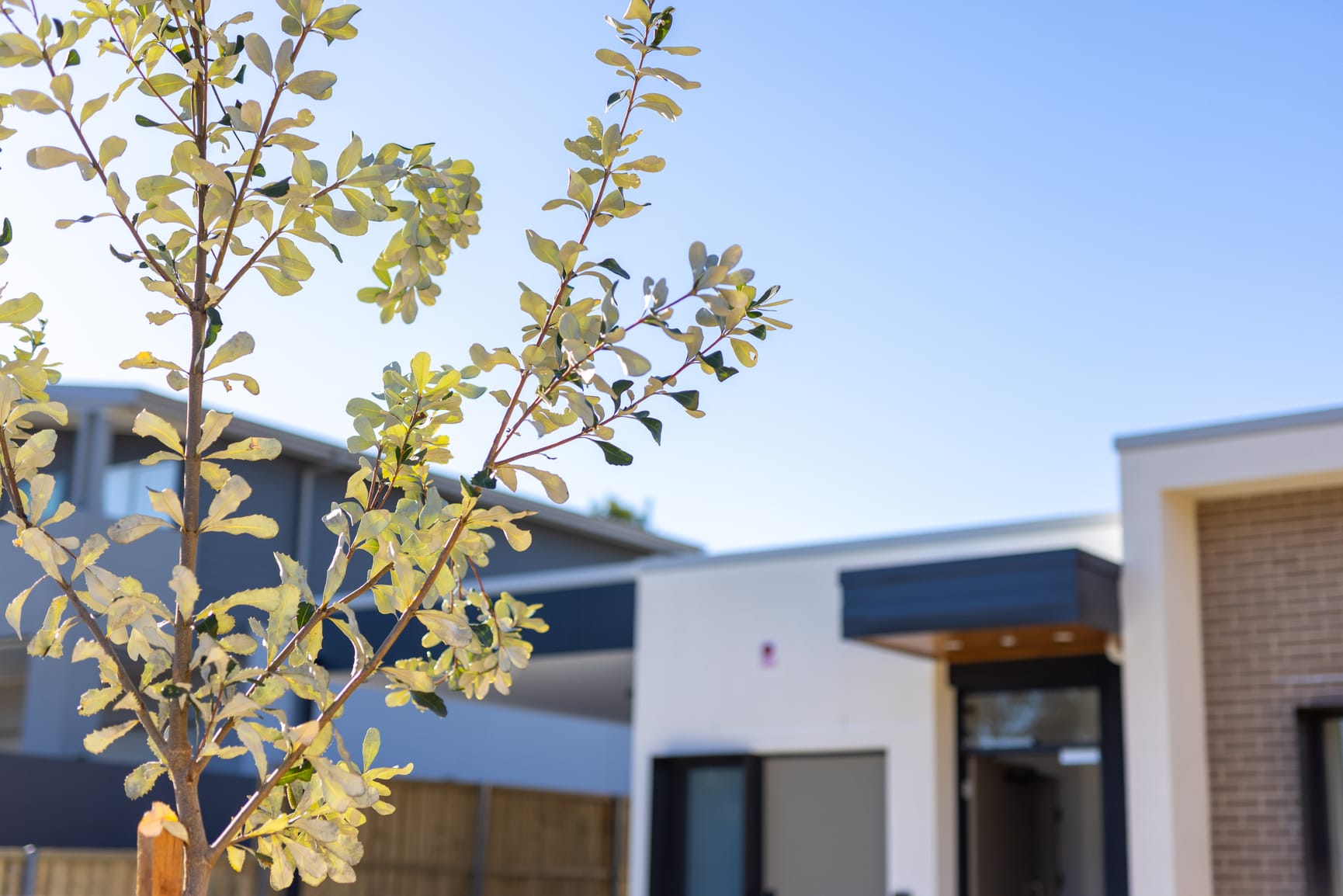

Specialist Disability Accommodation (SDA) is a core component of Australia’s National Disability Insurance Scheme (NDIS) and represents a compelling and underinvested segment of the alternative real estate market. It is estimated more than $14 billion in capital is required to deliver ~5,000 new dwellings by 2033, presenting a significant opportunity for investors.1
As a critical part of Australia’s social infrastructure, SDA housing delivers positive improvements in the quality of life for people with significant disability. The sector’s investment fundamentals are supported by underlying land values in key growth centres, potential development upside and government backed income streams indexed to inflation. These are further reinforced by persistent structural undersupply and strong demand driven by a shift away from inadequate legacy housing models towards participant-led accommodation.
SDA – delivering social infrastructure and stable yields
SDA is a needs-based social infrastructure opportunity that enables private capital to help address the critical undersupply of accommodation for individuals living with extreme functional impairments or very high support needs. Prior to the introduction of SDA funding, many people lived in settings that compromised their quality of life. The SDA framework was established to address systemic gaps and facilitate access to tailored housing solutions that align with participants’ needs and preferences.
Currently around 24,000 NDIS participants receive SDA support, with demand projected to grow significantly over the coming decade as awareness increases and the population of eligible participants expands.1
SDA funding enables the development of housing that is built to high accessibility standards – not only physically accessible but also tailored to enhance residents’ independence, privacy, and quality of life. These dwellings incorporate physical access features such as wider doorways, fully accessible bathrooms, reinforced ceiling hoists, emergency backup power and integrated smart-home technology, delivering both safety and empowerment.
SDA represents a deliberate and transformative shift away from inadequate legacy housing models such as group homes, aged care facilities or hospitals towards contemporary, participant-focused living environments emphasising independence and choice.
This transition necessitates substantial capital investment in a fragmented and underdeveloped sector. For early institutional investors SDA presents an opportunity to build scale and secure portfolios characterised by stable, recurring income and the potential for capital growth. It also represents an investment with a positive social impact, delivering long-term value through the transformation of Australia’s social housing infrastructure.
Bipartisan government support and funding – a compelling investment opportunity
The Australian federal government’s commitment to SDA provides a highly supportive policy and funding environment for private sector investment. With bipartisan support embedded in national disability strategy and budget priorities, SDA represents a strong investment opportunity within the social infrastructure space.
In FY25, the federal government allocated ~$600 million to SDA, representing around 1.2% of the total NDIS budget. This figure is expected to triple by 20332, reflecting both increasing participant demand and the government’s long-term commitment to the sector. Importantly, SDA funding is designed to attract private capital to deliver much-needed housing, while reducing the government’s own capital outlay and lowering system-wide costs across healthcare, aged care, and disability services. Forecasts indicate these reforms could deliver ~$6 billion in public sector savings by 2033.
For private investors in the sector, the SDA framework has been designed to encourage private capital to deliver purpose-built accommodation in exchange for government support which translates into a compelling opportunity to generate resilient and diversified income. This is achieved through recurring government-backed rental payments, maintenance fees, and care-linked infrastructure services. Around 90% of these income streams are non-discretionary and directly tied to NDIS entitlements, with built-in inflation protection via annual CPI-linked uplifts and periodic market review.
In addition to stable income, investments in SDA are typically underpinned by freehold residential property, providing exposure to long-term capital growth through rising land values. This is especially attractive in high-growth metropolitan and regional corridors where demographic shifts, urban renewal, and increased wealth are driving sustained property demand.
As the sector matures in Australia, it is expected to benefit from further efficiencies, technological innovation, and operational scale advantages – factors that can enhance returns and compress capitalisation rates. Trends seen in global disability housing and care infrastructure markets suggests significant scope for value creation as institutional capital deepens its footprint in the space.
A critically undersupplied market with strong demand tailwinds
Despite robust policy support and growing awareness, SDA remains critically undersupplied. To meet projected demand by 2033, an estimated 18,000 new SDA places, equivalent to ~5,000 dwellings, will need to be delivered across Australia.1 This includes approximately 10,000 existing places expected to be phased out due to outdated or non-compliant designs as industry standards evolve, further amplifying the need for modern, fit-for-purpose dwellings.
This pronounced demand-supply imbalance represents a $14 billion investment opportunity for the private sector, creating a significant runway for early institutional investors to gain exposure to a high-growth market.
Beyond the immediate undersupply, the SDA sector is supported by a strong combination of long-term tailwinds:
Demographic shifts: Australia’s ageing population and rising life expectancy are contributing to sustained demand for specialised, high-quality housing solutions that accommodate complex care needs. These demographic trends underpin long-term occupancy stability and revenue resilience.
Market fragmentation: the current SDA provider landscape is highly fragmented, comprising a mix of small not-for-profit operators and emerging private developers and a notable absence of large, scaled platforms. While select metropolitan areas show early signs of saturation in lower-support design types, demand for higher-need and regionally based accommodation remains unmet.
SDA Pricing Review: the 2023 NDIS SDA Pricing Review – the first formal review since the sector’s inception in 2016 – marked a turning point. Designed to align pricing with contemporary construction costs and incentivise development in areas of greatest need, the review led to a significant ~18.5% increase in funding. This not only bolstered sector economics but also reaffirmed long-term government commitment to encouraging private investment. The next pricing review, scheduled for 2028, is expected to further strengthen the investment case.
Superior return potential versus other real estate sectors
SDA offers a unique opportunity to access outsized returns relative to more established Australian real estate asset classes. Over the past decade, sectors such as childcare, healthcare, medical centres, and self-storage have undergone significant institutionalisation and consolidation resulting in sharp cap rate compression and strong capital appreciation.
In contrast, SDA remains an early-stage, underinvested sector with considerable scope for growth. The market is still characterised by fragmented ownership, limited institutional participation, and evolving operational models providing a first-mover advantage for investors.
As institutional capital increasingly invests in the sector, cap rates are expected to compress meaningfully, mirroring the evolution seen in other alternative real estate sectors.
More than a financial investment
The social need underpinning SDA investment is profound.
SDA addresses an urgent social need by providing people with a significant disability access to housing tailored to their individual needs. By funding the development of fit-for-purpose homes, SDA investors enable thousands of Australians to live with greater independence, dignity, and choice – improving quality of life not just for participants, but also their families and carers.
Without SDA, many individuals would need to reside in inappropriate and often more expensive institutional settings, such as aged care facilities, hospital wards, or outdated group homes. In addition to placing negative pressure on these institutions, these environments can severely limit quality of life, autonomy, and community inclusion.
To date, over 8,700 NDIS participants have benefited from newly developed SDA housing1, demonstrating the tangible, human impact of the program. As the sector scales, so too will the opportunity to deliver broad-based social value.
A compelling opportunity for astute investors
SDA represents a compelling opportunity in Australia’s alternative real estate landscape. With structural undersupply, strong bipartisan government support, and robust government-backed, inflation-linked income streams, SDA offers investors the potential for resilient returns and long-term capital growth.
As the sector matures and institutional capital flows into the market, early investors stand to benefit from yield compression, capital appreciation, and portfolio diversification while contributing to a high-impact social initiative.
For more information about our alternative real estate investment solutions, please get in touch.
1. EY Specialist Disability Accommodation Market Overview (2024).
2. EY Specialist Disability Accommodation Market Overview (2024) - NDIS budget over 12-month period to March 2024.
Important Information: This material has been prepared by MA Asset Management Ltd (ACN 142 008 535) (AFSL 327 515). The material is for general information purposes and must not be construed as investment advice. This material does not constitute an offer or inducement to engage in an investment activity nor does it form part of any offer or invitation to purchase, sell or subscribe for in interests in any type of investment product or service. This material does not take into account your investment objectives, financial situation or particular needs. You should read and consider any relevant offer documentation applicable to any investment product or service and consider obtaining professional investment advice tailored to your specific circumstances before making any investment decision. Any investment in a fund managed by MA Financial Group is subject to the terms and conditions of the relevant fund offer document. This material and the information contained within it may not be reproduced or disclosed, in whole or in part, without the prior written consent of MA Asset Management Ltd. Any trademarks, logos, and service marks contained herein may be the registered and unregistered trademarks of their respective owners.
Nothing contained herein should be construed as granting by implication, or otherwise, any licence or right to use any trademark displayed without the written permission of the owner. Statements contained in this material that are not historical facts are based on current expectations, estimates, projections, opinions and beliefs of MA Asset Management Ltd. Such statements involve known and unknown risks, uncertainties and other factors, and undue reliance should not be placed thereon. Additionally, this material may contain “forward-looking statements”. Actual events or results or the actual performance of MA Asset Management Ltd or an MA Asset Management Ltd financial product or service may differ materially from those reflected or contemplated in such forward-looking statements. Certain economic, market or company information contained herein has been obtained from published sources prepared by third parties. While such sources are believed to be reliable, neither MA Asset Management Ltd, MA Financial Group or any of its respective officers or employees assumes any responsibility for the accuracy or completeness of such information. No person, including MA Asset Management Ltd and MA Financial Group, has any responsibility to update any of the information provided in this material.





